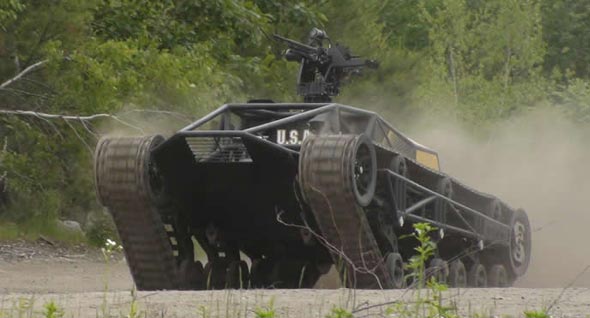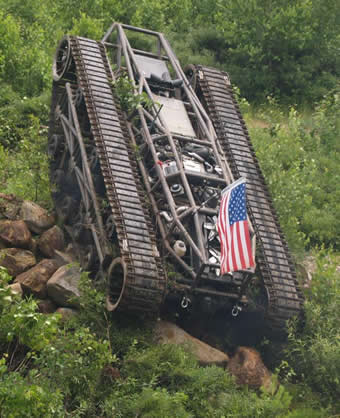Most UGV programs are utilizing vehicles that move rather slowly and require relatively complex control, lacking effective 360 degrees situational awareness. Consequently, they can be easily outmaneuvered and disabled by an enemy that could get close or out run the robot. The U.S. Army is evaluating a much larger, powerful, agile and lethal robot developed by the Howe & Howe (H&H) company, known as ‘RipSaw Military Specification 2’, that offers many advantages that minimize such vulnerabilities. The RipSaw-MS2 is being tested as a convoy security and support vehicle.


The RipSaw Military Spec 1 (MS1) unmanned tracked vehicle provided a test platform for advanced off-road capabilities. Its capability to rapidly move off-road has triggered the Army to evaluate it as a convoy support ‘guardian angel’. The vehicle can rapidly move alongside the convoy, without obstructing the convoy movement, rapidly securing suspected IEDs sites or responding to enemy fire from ambushes, suppressing enemy fire sources or towing immobilized vehicles out of the line of fire. The RipSaw-MS1 has recently demonstrated such capabilities during the ‘Robotics Rodeo’ at Ft. Hood. Beyond the convoy support mission, RipSaw has other potential missions, including perimeter defense, surveillance, rescue, border patrol, crowd control and explosive ordnance disposal roles.

The RipSaw uses multiple cameras to gain continuous, 360 degrees coverage, providing the operator an ‘always on’ full situational awareness. Furthermore, the vehicle is large enough to support an effective perimeter defense system which can stop anyone from getting close. This active self-protection system utilizes multiple M5 Modular Crowd Control Munitions (MCCM) charges mounted on a belt around the vehicle. Relying on this deterrent weapon, RipSaw can break into crowds employing the MCCM’s flash-bang effect or use the non-lethal rubber bullets to repel hostiles from approaching the vehicle. Similar weapons can also be used as offensive weapons. Other payloads accommodated already been tested with the platform, include counter-IED devices and mines.

The Ripsaw MS2 is tele-operated from a nearby M113. However, as a semi-autonomous vehicle, many of the control functions are computer assisted via ‘drive by wire’ controls. It is designed as a highly adaptive platform that can be integrated with multiple weapon systems and different mission payloads.
The RipSaw MS2 is only 1.77 meter high, thus capable to effectively blend in the terrain, and mask itself from enemy observation. The low silhouette is also beneficial when moving forward as an advanced fire base; RipSaw-MS2 has already been tested with the 7.62mm and .50 Cal machine guns. The vehicle was also demonstrated carrying Javelin missiles, but none were fired sofar. The vehicle was weaponized by the Armys Armament Research, Development and Engineering Center (ARDEC) at Picatinny Arsenal, NJ. The kit included the installation of a remotely controlled M240 machine gun operated from a separate console installed in the control vehicle.
The RipSaw Origins

Originally the Ripsaw ‘unmanned tank’ was developed as a ‘one of a kind’ backyard garage project. The developer, Howe and Howe Technologies received the attention of the U.S. military as they submitted the vehicle for the first DARPA Challenge of 2005.
Two years later the small developing company received their first contract from the U.S. Army Research, development and Engineering Command (REDCOM) Tank and Automotive Division which modified the vehicle into an ‘unmanned ground vehicle capability demonstrators’.
The current version, called RipSaw MS2 was designed to be bigger, faster and more modular, than the MS1. The vehicle can take significant combat damage and still be rapidly repaired in the field, to be ready to fight another day. According to the manufacturer, unlike other vehicles that are usually damaged beyond repair by mine blast or IEDs, as damaged RipSaw could be ‘cannibalized’ in the field for its undamaged modules and assembled into a fully capable vehicle overnight.
Born to be Wild…


Weighing 4.5 ton (9,000 lbs) the RipSaw MS2 vehicle is sized like a HMMWV. It can carry about one ton (2,000 lbs) of payload and be controlled remotely or operated by a driver and a crewman. The vehicle uses a lightweight tubular chassis design, derived from NASCAR race cars, powered by a 6.6 liters duramax diesel engine, developing 600 hp and 1000 ft/lb of torque, providing exceptional power to weight ration for vehicles at this class. Fully weaponized and loaded, the RipSaw MS2 can accelerate from 0 to 50 mph in 5.5 seconds (!) reaching a top speed of about 60 mph. “Ripsaw is very quick and agile, it can easily outmaneuver a human” Michael Howe told Defense Update, indicating this is not trivial for a UGV.
The high power-to-weight ratio, efficient suspension and low ground pressure are providing RipSaw MS2 with exceptional maneuverability. Its center of gravity is located 70 cm (30″) above, contributing to the high stability in steep gradient (50degrees) and side slope (45 degrees). High ground clearance (60cm – 24″) and relatively low weight, wide tracks and the suspension’s long travel maintain low ground pressure of 2.8 lbs/square inch. This attribute enables the vehicle to traverse rugged terrain at high speed, negotiate vertical obstacles up to 1.5 meter (60″) high or rip through barriers like a heavy tank.
The innovative mechanical clutching system that controls the hydrostatic transmission with the power, speed and simplicity of a mechanical drive system is responsible for the vehicle’s rapid acceleration, maneuverability and control.
For a detailed review of the RipSaw MS1, check this 2008 Defense Review article by David Crane.

















